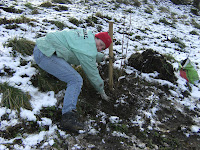132. It's time to go foraging...

As many of you will know (and read on my blog) we planted over 100 trees in our foraging hedge in March. The photo below shows its current progress. I wrote an article all about it, 'The Foraging Hedge Rulebook', which is being published in the September / October issue of Living Woods magazine. http://www.living-woods.com/ It starts... The Foraging Hedge Rulebook Following his recent experience of planting a 40-metre, 106-tree foraging hedge, James Ellson explains The Foraging Hedge Rulebook , 10 Rules to follow when planting such a hedge. The increasing interest in foraging has resulted in what many people think is a resurgence in planting foraging hedges. However, a foraging hedge is a modern adaptation of ancient traditions. This article will begin by exploring a little of the history of the hedge and of foraging, and suggest how the foraging hedge came about. Everyone has heard of the Great Wall of China but very people know about the Great Hedge of Indi...


